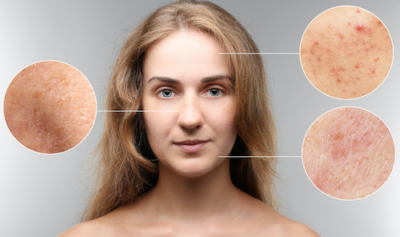Acne
What is Acne?
Acne is a common but disheartening condition that affects 80% of adolescents, but can also trouble adults, particularly women, at any age. Blackheads, whiteheads, and pimples can erupt for months, years or even decades.

For some, there are subtle breakouts over the T-zone (chin, nose, and forehead) only. For others, the changes are more dramatic and can lead to scarring of the face, chest, and back. If the acne lesions are painful, large, or resolve leaving behind a pitted or discolored area, or if there is extensive involvement of the face, chest or back, it is time to see the doctor. Some pediatricians are adept at treating acne, particularly of the mild to moderate variety. A dermatologist, however, can provide a full array of treatment for mild acne all the way to severe scarring acne. If acne is mild, as it is for most teens, a trial of over-the-counter acne medication is in order.
What Treatment Options are Available for Acne?
The least irritating treatment is a wash that contains salicylic acid (such as Neutrogena Oil-Free Wash). This helps to unclog pores which prevent the formation of pimples and comedones (black heads and white heads). Start the wash and wait at least 1 week before adding a second treatment to assess if your child is allergic to the active ingredient, salicylic acid.
Week 2 add a cream containing benzoyl peroxide (BP). BP kills bacteria and decreases inflammation in the follicle where acne pimples form. Creams that contain 10% BP are very harsh and irritating and work no better than creams containing a lower percentage. Try to find a product containing 2.5% to 5% benzoyl peroxide. Apply a small amount of BP product to the entire acne-prone area, not just active pimples, once per day (try Neutrogena Rapid Clear Daily Mask). Keep in mind that BP can bleach clothing and bedding, so white pillowcases and towels are recommended. About 5% of people are allergic to or irritated by benzoyl peroxide, so if the skin becomes red, itchy or swollen, stop the cream immediately. Pregnant women should not use any over-the-counter or prescription acne medication without first consulting their doctor.
It takes a full 2 months to see the improvement from any acne treatment, even the strongest oral therapy. So patience is the key here. If the acne is more substantial, or if at the 2-month point mild acne is still present, retinoids are the next step. These topical medications include gels and creams that are made of Vitamin A derivatives to unclog the follicles. Recently one of the best prescription retinoids was approved for over-the-counter sale. Differin 0.1% gel or Effaclar Adapalene gel can be purchased inexpensively at your local pharmacy. Adapalene 0.1% cream, and 0.3% gel, tretinoin (Retin-A) and tazarotene (Tazorac) still require prescriptions. To combine the helpful effects of retinoids and benzoyl peroxide together, try over-the-counter Effaclar Duo which is the first non-Rx to contain both ingredients. To avoid irritation, start your retinoid every other night for a week or two, then increase to nightly as tolerated. Use an oil free moisturizer on top of the retinoid to minimize dryness.
Once the over-the-counter medications have been exhausted, prescription topical and oral medications may be necessary for persistent acne. Oral options include antibiotics, hormonal medications for women (such as birth control pills) and finally the oral Vitamin A derivative isotretinoin (Accutane). The risks and benefits of all of these options should be reviewed with a knowledgeable dermatologist.
What Causes Acne?
Acne is largely genetic, and is also affected by hormones, hence its appearance and persistence throughout puberty, and sadly reappearance during early menopause. Though it may be tempting to tell your teen that french fries and donuts cause their acne, that isn’t the case. High dairy intake, particularly skim milk, has been associated with acne but is not the primary cause. Some moisturizing creams and heavier sunscreens can make acne worse. Make sure all products used on the skin have the words “non-comedogenic” or “oil-free” on their label. Moisturizers are often necessary to counteract the dryness from the acne treatment medications. Some non-comedogenic choices are SkinMedica Ultra Sheer Moisturizer, Neutrogena Gel Boost and Cerave moisturizers.
Although facials and glycolic peels may be helpful in some patients, they do not replace the need for evaluation and the prescription of appropriate medications. Don’t wait until scarring sets in to have your, or your child’s acne treated. Acne treatment is a process. It may take months to come up with the best treatment while minimizing the potential side effects of acne medication. For acne scarring that persists despite adequate acne control, don’t fear. Krauss Dermatology has a variety of treatments that can help including the Fraxel® Dual Laser.

